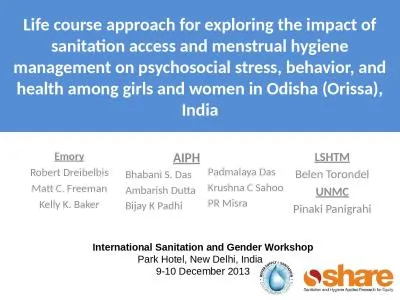

Odisha Orissa India AIPH Bhabani S Das Ambarish Dutta Bijay K Padhi Padmalaya Das Krushna C Sahoo PR Misra International Sanitation and Gender Workshop Park Hotel ID: 913176
Download Presentation The PPT/PDF document "Life course approach for exploring the i..." is the property of its rightful owner. Permission is granted to download and print the materials on this web site for personal, non-commercial use only, and to display it on your personal computer provided you do not modify the materials and that you retain all copyright notices contained in the materials. By downloading content from our website, you accept the terms of this agreement.
Slide1
Life course approach for exploring the impact of sanitation access and menstrual hygiene management on psychosocial stress, behavior, and health among girls and women in Odisha (Orissa), India
AIPHBhabani S. DasAmbarish DuttaBijay K PadhiPadmalaya DasKrushna C SahooPR Misra
International Sanitation and Gender
Workshop
Park Hotel, New Delhi, India 9-10 December 2013
EmoryRobert DreibelbisMatt C. FreemanKelly K. Baker
LSHTMBelen Torondel
UNMC
Pinaki Panigrahi
Slide2Gender, Sanitation, and Health in Odisha
In Odisha over 88% of rural population do not have adequate sanitation facilities (Govt. of Odisha Annual Plan 2011-12)
Odisha lags far behind in terms of access to toilet facilities and safe drinking water.
Between 2001–2010 sanitation coverage increased from 8% to
42%, but sustained toilet usage, and adoption of best hygiene practices remain key challenges. Girls and women can experience gender-specific challenges in using available sanitation services.
May be particularly susceptible to hygiene-related diseases caused by decreased sanitation use.
Slide3Conceptual Model of Sanitation Access on Behavior and Health in girls and women
EXPOSURES
PSYCHOSOCIAL STRESS
MHM
UROGENITAL INFECTIONSPRETERM BIRTH
Sanitation Access (Household and Community)
OUTCOMES
USE IN PREGNANCY
RA1
RA2
RA3
Slide4http://gomyugomyu.deviantart.com/art/From-Cradle-to-Grave-176209118
Female Life CourseMenarche: 14 years (12-16)
Menopause: 47 years(40-48)
~33 years
1716 days for defecation/urination370 menstrual cycles2.7 births (1 wealthiest – 8 poorest)
Slide5Interconnected study design
POPULATION SURVEY
CROSS-SECTIONALSTATISTICS (4000 HH):Life course stageSocio Economic Status
WASH access and useMHM practicesStress responses
2 week reported UTI/BV SymptomologyHUAS for UTI/BV
Adolescence:13 – 18 yrsNot marriedNewly married:Within one year,Lives with in-lawsPregnant
Married or previously marriedMENSTRUATING
Slide6Sub-Study I: Sanitation-related Psychosocial Stress (SRPS)
SRPS and its associated health risks and social/behavioral adaptations not fully understoodBroader literature on water, sanitation, and hygiene (WASH) suggest that there is a strong link between WASH access and mental health outcomesDynamic in natureTemporal: daily stresses, periodic stresses (menstruation, pregnancy), long-term (incontinence)
Life course: onset of menses, marriage and relocation into in-law’s home, pregnancy, child-rearing
Slide7PSYCHOSOCIAL STRESS
Slide8PSYCHOSOCIAL STRESS
Exploratory, mixed-methods design in which unstructured qualitative research leads to instrument development for SRPSStratified by life-stage and geographic location
Slide9Sub-Study II:
MHM association with health outcomesBackground:Systematic Review (Sumpter and Torondel
2013):1. Evidence for the impact of menstrual hygiene management (MHM) on Health outcomes was found in 13 articles. 2. Plausible association: good MHM and reduction of RTI. Unclear about:
-Specific infections -Strength of effect -Route of transmission
- Role of water and sanitation access -Definition of “good menstrual hygiene management” Relevance in India: Between 43 and 88% of girls wash and reuse cotton clothes. Prevalence of UTI range (25-60%) and BV (15-25%).
Slide10Menstrual hygiene Management
(absorbent type, WASH conditions)Are menstrual hygiene management practices (including type of absorbent used, pad hygiene practices and women WASH practices) risk factors for bacterial
vaginosis and urinary tract infections?Are menstrual hygiene practices associated with increased microbial contamination in menstrual absorbent pads?
Health outcomes:
Bacterial Vaginosis Urinary tract InfectionsResearch Aim:
Slide11-
Number of women: 500-Location: 2 hospitals (Bhubaneswar and Rourkela)
Odisha-Inclusion criteria
: Women attending to gynaecology clinic, 18-45 years old Non-Pregnant
Non menstruating during clinic visit Cases: Women with one or more of the following symptoms: Abnormal vaginal discharge Burning or itching in the genitalia Burning or itching when urinating.Controls: Women with none of the above symptoms-Risk factor assessment:
QuestionnaireQA/QC: Exit interview-Disease assessment: Laboratory diagnostic: BV: Amsel/Nugent criteria and UTI: culture microbiology test.QA/QC: Examination of slides for Clue cell by an independent evaluator in 10% slides
Study design: Case-Control hospital based study
Slide12Sub-Study III:
WASH Access, Use, and Preterm Birth
Design:
Observational prospective cohort study.
Setting
: Rural (
Balianta & Balipatana
) and Tribal (
Kuanrmunda
and
Lathikata
) in Odisha, India.
Participants
: All eligible pregnant women (18-45 aged).
Main Exposures:
WASH practices and if any changes occurs during the course of pregnancy
Outcome Measures:
Adverse pregnancy outcomes (LBW-<2500g, PTB-<37 weeks of gestation).
Slide13Time Frame of Follow-ups
Birth Outcomes
Eligible Pregnant enrolled for
follow-ups using questionnaire
12-15 Weeks:
First visit
Consent
obtain
32-33 Weeks:
Third
Visit
35-36 Weeks:
Fourth
Visit
23-24 Weeks:
Second
visit
Slide14Human Resources Engaged in the
Study
Project
Manager
(
Bibhu)
Area Manager @ RKL:
(
MS
Nitin
Guria
)
Area
Manager @
BBS
(Mr.
Haraprasad
)
Supervisor (10 Nos.)
Supervisor (15 Nos.)
7-CHW/ Supervisor
7-CHW/ Supervisor
Each
CHW will
follow
~
4 pregnancies
Project Investigator (s)
(Bijay, Pinaki, Kelly)
Enrollments:
487 out of 600 (from 15
th
September to 30
th
November 2013).
QA/QC Testing
: 10% of the 1
st
phase data has been tested for QA/QC.
Adverse Pregnancy outcomes so far:
only one subject has spontaneous abortion at week 21.
Slide15Future Road Map
Geo-coding of the householdsEnrollment of Eligible SubjectsDemographic and socio-cultural dataWASH Exposure assessmentProspective follow-up and outcome measures
Surveillance
Evidence
generation for policy implementationEvaluationIdentification of key interventions to reduce exposures
Innovation
Slide16Addressing knowledge gaps
Impact of limited sanitation is more expansive than infectious disease outcomes Important to understand and quantify social and mental health impactsExperience-centric characterization of role of limited sanitation access on hygiene behavior in women Temporal or life-course gender-specific stressesBeyond diarrhea – promotes system-level thinking about role of sanitation access/use on spectrum of diseasesNew concepts for at-risk populationsIndividual-centric perspective on burden of sanitation-associated disease over life course
Consequence of cumulative body of gender experiencesPolicy - is existing health system effectively measuring and treating gender-specific sanitation-associated disease?
- What obstacles must health and environmental policy address?
Slide17Improving Public Health through Innovation & Alliance